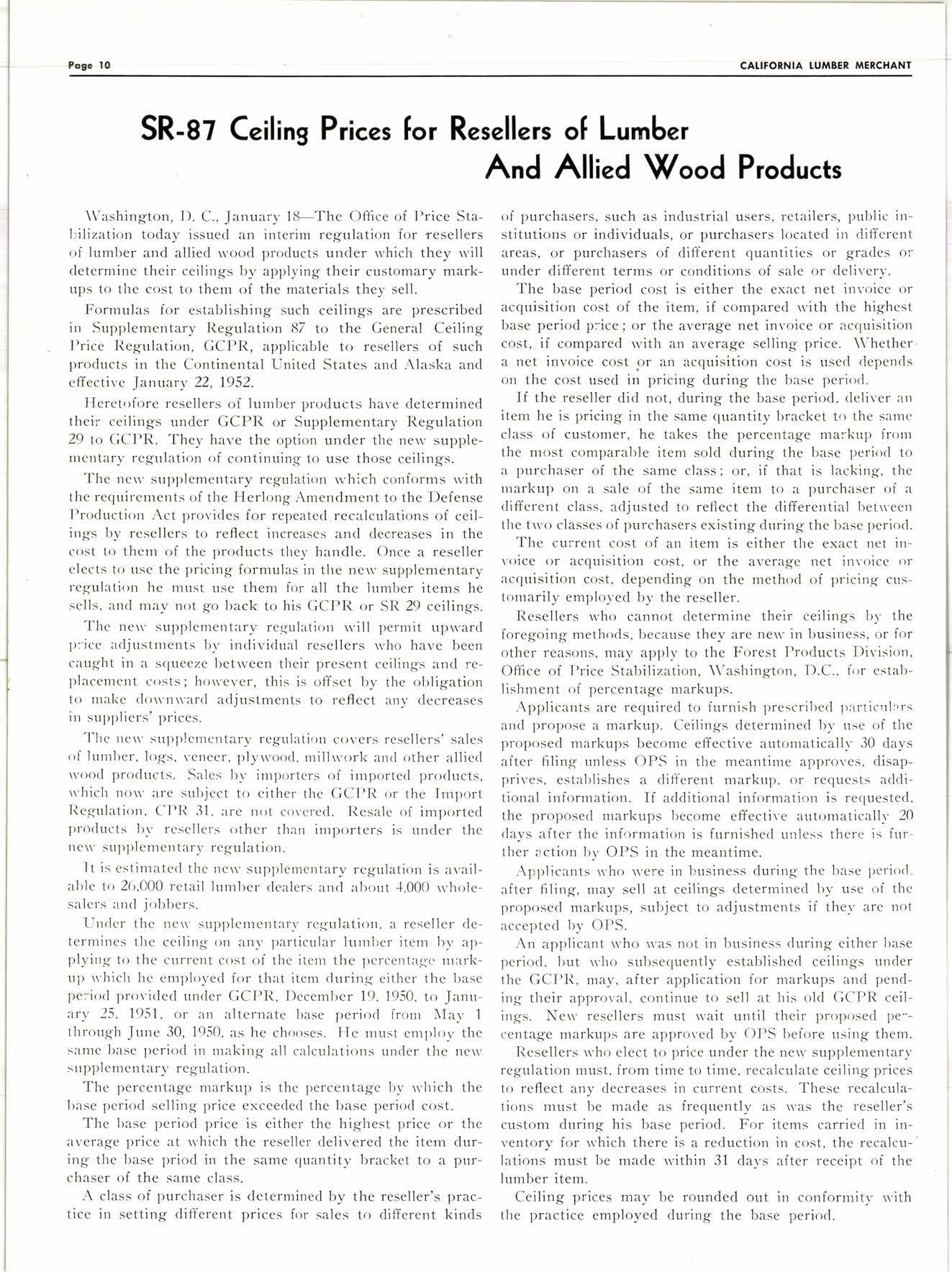
4 minute read
SR-87 Ceiling Prices for Resellers of Lumber And Allud \(/ood Products
\Vashington, I). C., January 1S-The Offrce of I'rice Stal:ilization today issued an interirn regulation for resellers of lun.rber and allied r,vood products under u'hich they rvill determine their ceilings l>y applying their customary markups to the cost to them of the materials they sell.
Fclrmulas for establishir-rg such ceilings are prescribed in Supplementary I{egulation 87 to the General Ceiling L'rice Regulation. GCPR, applicable to resellers of such products in the Continental United States and Alaska and effective January 22, 1952.
Heretofore reseilers of lurnber products have determined their ceilings under GCPR or Supplementary Regulation 29 to GCPR. They have the option under the neu' supplenrentary regulation of continuing to use those ceilings.
'fhe ncu' supplementary regulati<ln rvhich conforms rvith thc requirenrents of tl.re Herlong Amendment to the Defense .Production Act provicles for repeated.recalculations of ceilings by resellers to reflect increascs and decreases in the cost to thcnr of the products they harrdle. Once a reseller elects to usc the pricing formulas in the nen' supplementary regulation he must use them for all the lumber items he sells. and may not go back to his GCPR or SR 29 ceilings.
Thc nen' supplernentlrrv regulatiorr rvill lternrit upn'ard 1r:-icc adjustments bv individual resellers rl'ho have been cauglrt in a sclueeze ltetween their present ceilings and replacen.rent c()sts; hou.errcr, this is offset by the obligation to nralie clou'tru-ar<l adjustmerrts to reflect any clecreases irr suppliers' prices.
Tlrc neu' srrpplcnrcntary regulati()n c()vers resellers' sales oI lunrlrer, logs, r.eneer, plyrvoocl, rrrill.n'ork arrtl other allied rvood proclucts. Sales l>,f intportcrs of irlportetl prriducts, u'hich r1()\\' urre srrbjcct to either the GCITR or the In-rport Iiegulation. CI'Il 31, ure not cor.crcd. Resalc of imported proclucts ltv rcsellers other tharr iurporters is rrnder the neu' supplemcntary rcgulation.
Tt is estimzrte<l thc neu' supltlementary rcgulation is availalrle trr 2(t.AA0 retail lrrrr-rber dealers and abont .1.000 u.holes:rlcrs an<l jobbers.
Unrlcr the rren- su1>plenrentarv rcgulation, a reseller cleternrines the ceilirrg or1 irny particular lun.rber item bv applying to the current cost of the iten'r the pcrcerrtasc nurrkuP u'hich hc emPloyed for that item during cither the base ire:-io<l proviclecl rrn<ler GCPR, Dccembcr 19, 1950. to Janrrar_v 25. 1951, or an alternate base period fronr NIay 1 through Jrrne 30, 19.50. as hc chooses. tle nrust employ the same lrase periocl irr making all calculations under the ncu, supplenrentary regulation.
Thc percer.rtage nrarkup is thc percentagc bv l'hich the base pcriod sclling price exceeded the base period cost.
The base period price is either the highest price or the average price at t'hich the reseller delivered the item during the l>ase priod in the same quantity ltracket to a prlrchaser of the same class.
A class of purchaser is determined by the reseller's practice in setting differerrt prices for sales to different kinds of purchasers, such as industrial users, retailers, public institutions or individuals, or purchasers located in diffcrent areas, or purchasers of different quantities or gracles or' under different terms or conditions of sale or clelivery.
The base period cost is either the exact net invoice or acquisition cost of the item, if compared u'ith the highcst base period p:ice ; or the average net inr.oice or accluisitiorr cost, if compared rvith an average selling price. Whether a net invoice cost or an acquisition cost is used depends orr the cost used in pricing during tl.re base period.
If the reseller did not, during the base period, clelir-er:rrr itern he is pricing in the same quantity bracket to the samc class of customer, he takes the percer.rtage marknp fronr the mclst comparable item sold during the bzrse period to a purchaser of the same class ; or, if that is lackirrg, the markup on a sale of the same item to a purchaser of a <lifferent class, adjusted to reflect the differential betu-eer.r the turo classes of purchasers existing during the base periocl.
The current cost of ar.r item is either the exact net iuvoice or acquisition cost, or the average net itrvoice or accluisition cost, depending on the method of pricing customarily employecl by the reseller.
Resellers u'ho cannot cletermine their ceilings b1-the foregoing methods, because they are net, in busirress, or for other reasons, may applv to the Forest Products I)ir,ision, Office of I'rice Stabilization, \\'ashington, D.C., for establishment of percentage markups.
Applicants are required to furnish prescribed prrrticr.tllrs and propose a markup. Ceilings determined by rrse of tl.re proposed markups become effective automaticallr- 30 days after filing unless OPS in tl.re meantirne approves, disapprives, establishes a difterent markrrp, or requests aclditional information. If additional information is recluestecl. the proposed rnarkups become effective automaticallv 20 days after the informatjon is furnishe<l unless there is further action by OPS in the meantime.
Applicants l'ho l'ere in business during the base periocl after filing, may sell at ceilings detern.rinecl by use of thc proposed markups, subject to adjustmerrts if thev are not accepted by OPS.
An :rpplicant n'ho \\'as not in business cluring either base period. but u,ho snbsequently established ceilir-rgs trnder the GCPR, may, after application for markups and pending their approval, continue to sell at his old GCPR ceilings. Neu' resellers mttst n'ait rrntil their proposecl 1re-centage markups are approved by OPS before using them.
Resellers u'ho elect to price under the neu, supl)lementary regulation rnust, from time to time, recalculate ceiling prices to reflect any decreases in cnrrent costs. These recalculations must be made as frequently as n'as the reseller's custom during his base period. For items carried in in\.entory for n'hich there is a reduction in cost, the recalculations must be made rvithin 31 da1's after receipt of the lrrmber item.
Ceiling prices may be rounded out ir.r conforr.nitl. l'ith the practice employed during the base period.










